Economics for Business: Analysis of UK Housing Sector (2006-2016)
VerifiedAdded on 2021/04/19
|21
|4169
|57
Report
AI Summary
This report provides an in-depth analysis of the UK housing market from 2006 to 2016. It examines the dynamics of house prices, highlighting the fluctuations observed during the period, including the impact of the 2008 financial crisis. The report explores the various factors influencing housing prices, such as economic growth, supply and demand gaps, and consumer confidence. It also analyzes the effects of government schemes and policies aimed at supporting first-time buyers and stabilizing the market. The analysis is divided into pre- and post-crisis periods, offering insights into the changing market conditions and their drivers. The report concludes with a summary of the key findings and their implications for the UK housing sector.
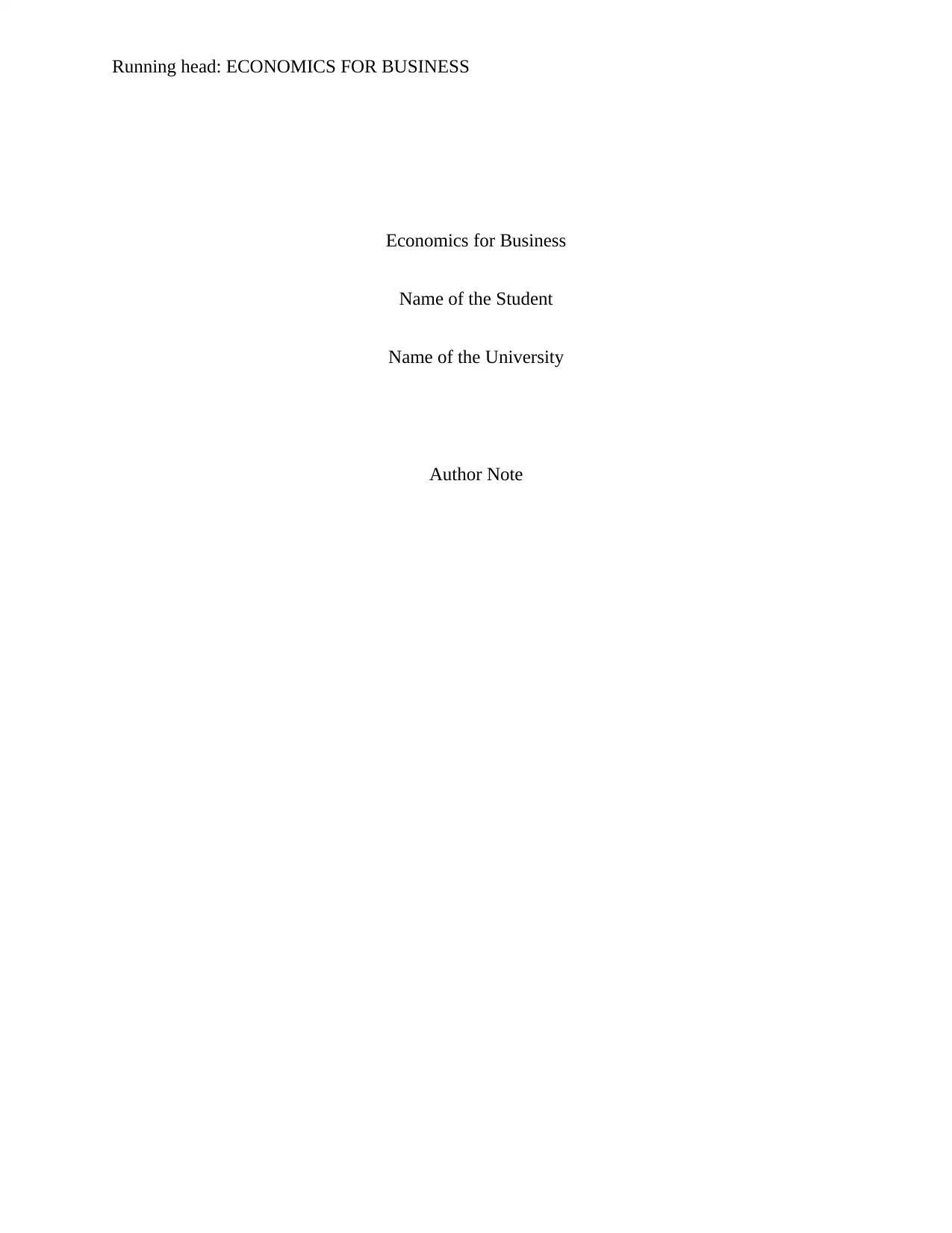
Running head: ECONOMICS FOR BUSINESS
Economics for Business
Name of the Student
Name of the University
Author Note
Economics for Business
Name of the Student
Name of the University
Author Note
Paraphrase This Document
Need a fresh take? Get an instant paraphrase of this document with our AI Paraphraser
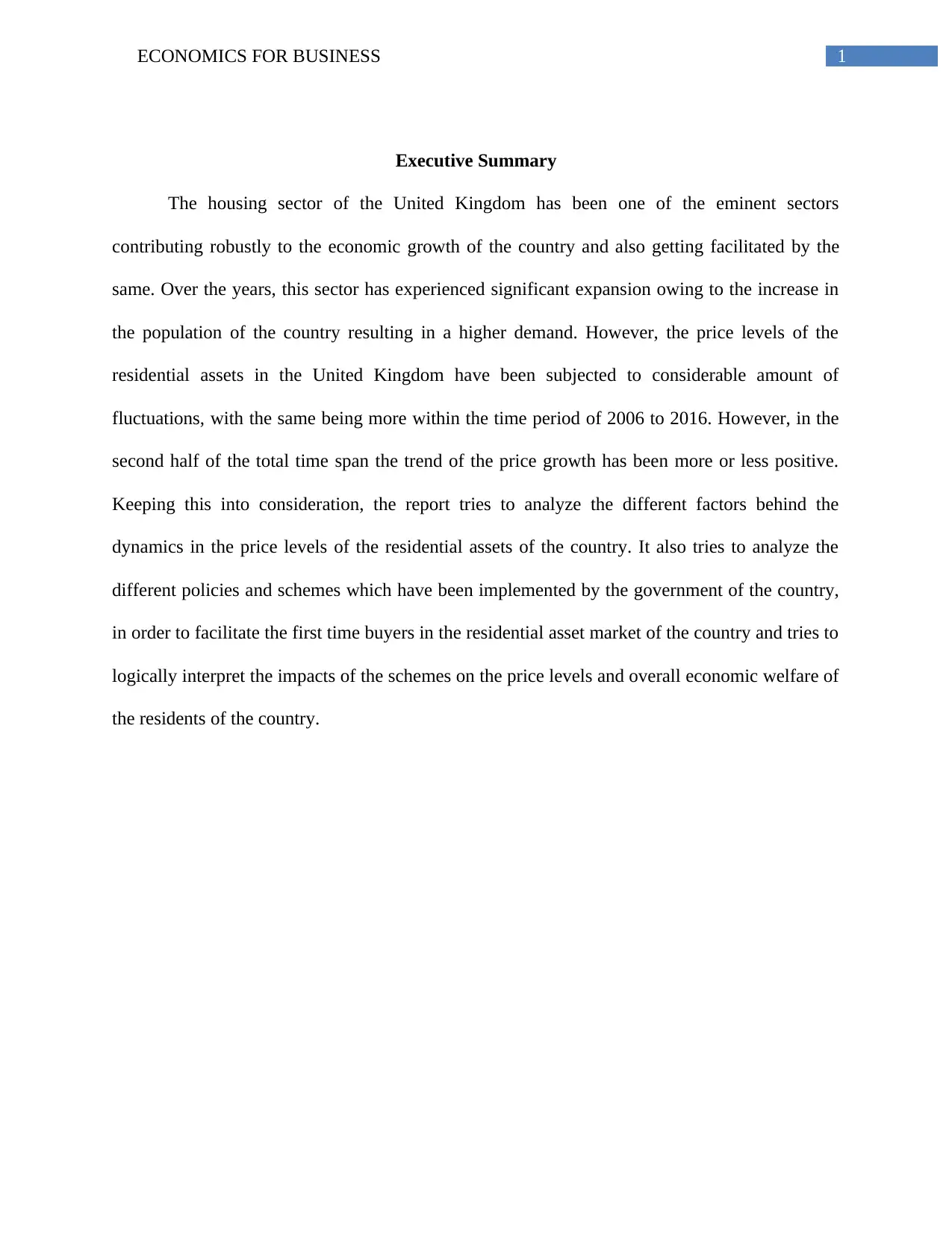
1ECONOMICS FOR BUSINESS
Executive Summary
The housing sector of the United Kingdom has been one of the eminent sectors
contributing robustly to the economic growth of the country and also getting facilitated by the
same. Over the years, this sector has experienced significant expansion owing to the increase in
the population of the country resulting in a higher demand. However, the price levels of the
residential assets in the United Kingdom have been subjected to considerable amount of
fluctuations, with the same being more within the time period of 2006 to 2016. However, in the
second half of the total time span the trend of the price growth has been more or less positive.
Keeping this into consideration, the report tries to analyze the different factors behind the
dynamics in the price levels of the residential assets of the country. It also tries to analyze the
different policies and schemes which have been implemented by the government of the country,
in order to facilitate the first time buyers in the residential asset market of the country and tries to
logically interpret the impacts of the schemes on the price levels and overall economic welfare of
the residents of the country.
Executive Summary
The housing sector of the United Kingdom has been one of the eminent sectors
contributing robustly to the economic growth of the country and also getting facilitated by the
same. Over the years, this sector has experienced significant expansion owing to the increase in
the population of the country resulting in a higher demand. However, the price levels of the
residential assets in the United Kingdom have been subjected to considerable amount of
fluctuations, with the same being more within the time period of 2006 to 2016. However, in the
second half of the total time span the trend of the price growth has been more or less positive.
Keeping this into consideration, the report tries to analyze the different factors behind the
dynamics in the price levels of the residential assets of the country. It also tries to analyze the
different policies and schemes which have been implemented by the government of the country,
in order to facilitate the first time buyers in the residential asset market of the country and tries to
logically interpret the impacts of the schemes on the price levels and overall economic welfare of
the residents of the country.
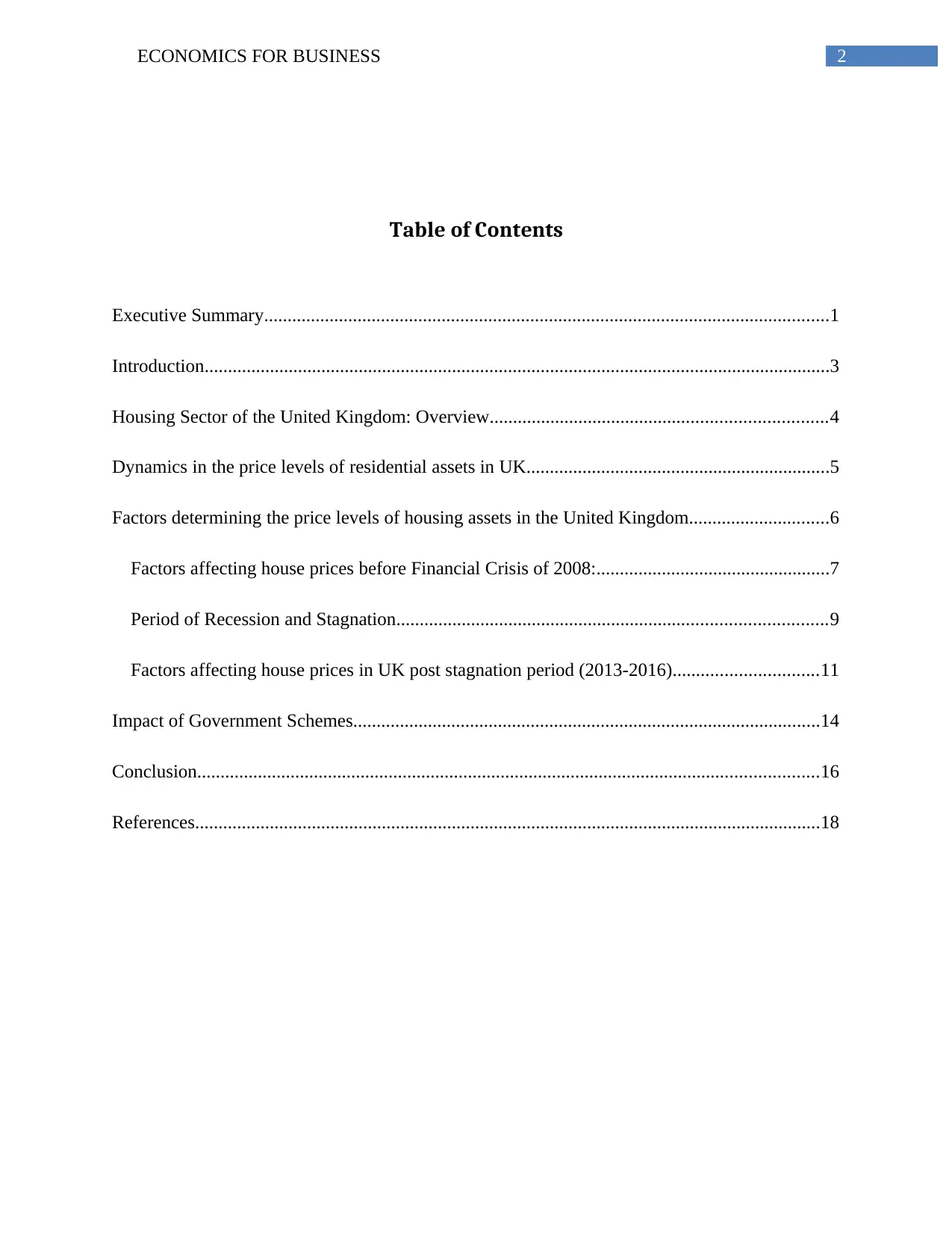
2ECONOMICS FOR BUSINESS
Table of Contents
Executive Summary.........................................................................................................................1
Introduction......................................................................................................................................3
Housing Sector of the United Kingdom: Overview........................................................................4
Dynamics in the price levels of residential assets in UK.................................................................5
Factors determining the price levels of housing assets in the United Kingdom..............................6
Factors affecting house prices before Financial Crisis of 2008:..................................................7
Period of Recession and Stagnation............................................................................................9
Factors affecting house prices in UK post stagnation period (2013-2016)...............................11
Impact of Government Schemes....................................................................................................14
Conclusion.....................................................................................................................................16
References......................................................................................................................................18
Table of Contents
Executive Summary.........................................................................................................................1
Introduction......................................................................................................................................3
Housing Sector of the United Kingdom: Overview........................................................................4
Dynamics in the price levels of residential assets in UK.................................................................5
Factors determining the price levels of housing assets in the United Kingdom..............................6
Factors affecting house prices before Financial Crisis of 2008:..................................................7
Period of Recession and Stagnation............................................................................................9
Factors affecting house prices in UK post stagnation period (2013-2016)...............................11
Impact of Government Schemes....................................................................................................14
Conclusion.....................................................................................................................................16
References......................................................................................................................................18
⊘ This is a preview!⊘
Do you want full access?
Subscribe today to unlock all pages.

Trusted by 1+ million students worldwide
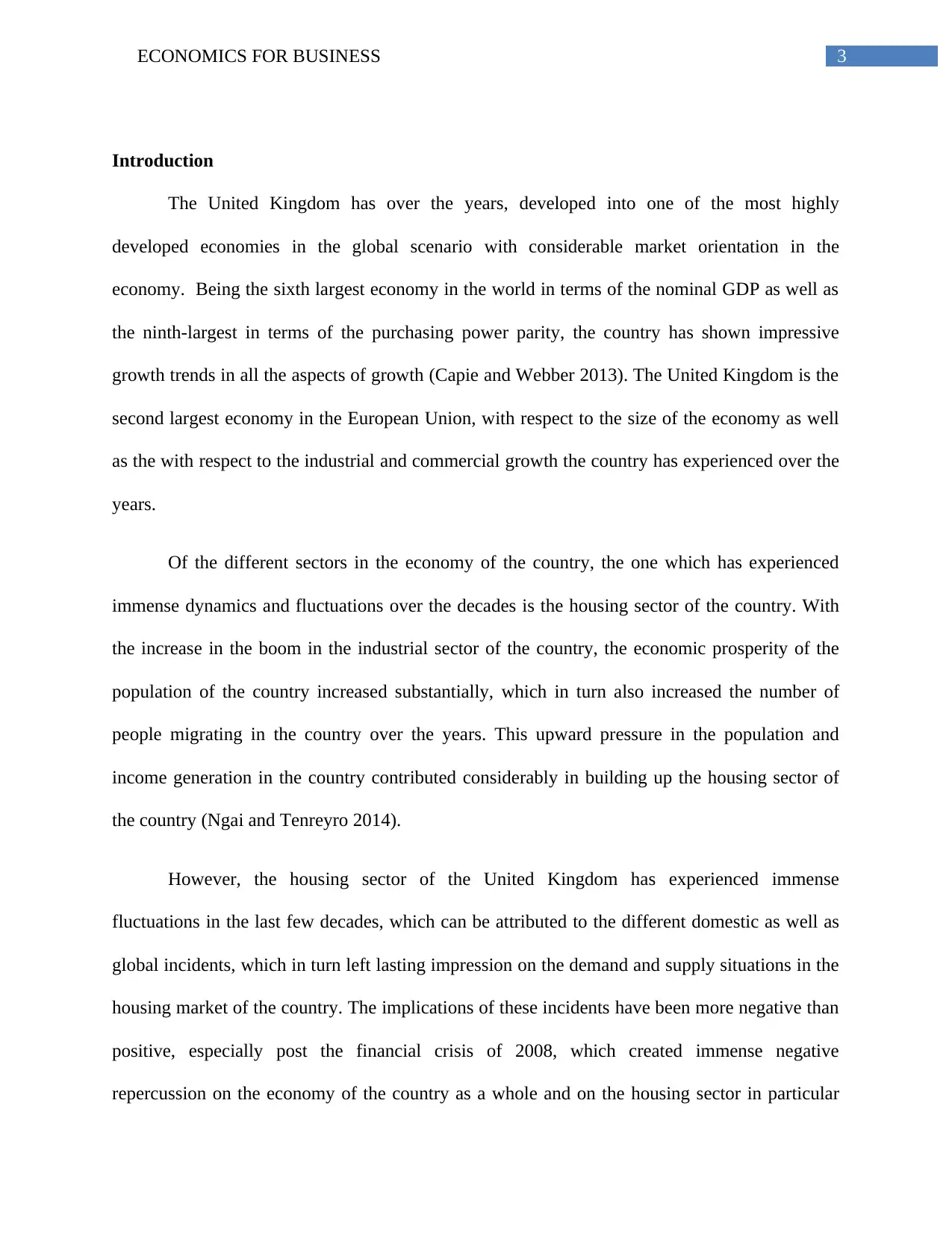
3ECONOMICS FOR BUSINESS
Introduction
The United Kingdom has over the years, developed into one of the most highly
developed economies in the global scenario with considerable market orientation in the
economy. Being the sixth largest economy in the world in terms of the nominal GDP as well as
the ninth-largest in terms of the purchasing power parity, the country has shown impressive
growth trends in all the aspects of growth (Capie and Webber 2013). The United Kingdom is the
second largest economy in the European Union, with respect to the size of the economy as well
as the with respect to the industrial and commercial growth the country has experienced over the
years.
Of the different sectors in the economy of the country, the one which has experienced
immense dynamics and fluctuations over the decades is the housing sector of the country. With
the increase in the boom in the industrial sector of the country, the economic prosperity of the
population of the country increased substantially, which in turn also increased the number of
people migrating in the country over the years. This upward pressure in the population and
income generation in the country contributed considerably in building up the housing sector of
the country (Ngai and Tenreyro 2014).
However, the housing sector of the United Kingdom has experienced immense
fluctuations in the last few decades, which can be attributed to the different domestic as well as
global incidents, which in turn left lasting impression on the demand and supply situations in the
housing market of the country. The implications of these incidents have been more negative than
positive, especially post the financial crisis of 2008, which created immense negative
repercussion on the economy of the country as a whole and on the housing sector in particular
Introduction
The United Kingdom has over the years, developed into one of the most highly
developed economies in the global scenario with considerable market orientation in the
economy. Being the sixth largest economy in the world in terms of the nominal GDP as well as
the ninth-largest in terms of the purchasing power parity, the country has shown impressive
growth trends in all the aspects of growth (Capie and Webber 2013). The United Kingdom is the
second largest economy in the European Union, with respect to the size of the economy as well
as the with respect to the industrial and commercial growth the country has experienced over the
years.
Of the different sectors in the economy of the country, the one which has experienced
immense dynamics and fluctuations over the decades is the housing sector of the country. With
the increase in the boom in the industrial sector of the country, the economic prosperity of the
population of the country increased substantially, which in turn also increased the number of
people migrating in the country over the years. This upward pressure in the population and
income generation in the country contributed considerably in building up the housing sector of
the country (Ngai and Tenreyro 2014).
However, the housing sector of the United Kingdom has experienced immense
fluctuations in the last few decades, which can be attributed to the different domestic as well as
global incidents, which in turn left lasting impression on the demand and supply situations in the
housing market of the country. The implications of these incidents have been more negative than
positive, especially post the financial crisis of 2008, which created immense negative
repercussion on the economy of the country as a whole and on the housing sector in particular
Paraphrase This Document
Need a fresh take? Get an instant paraphrase of this document with our AI Paraphraser
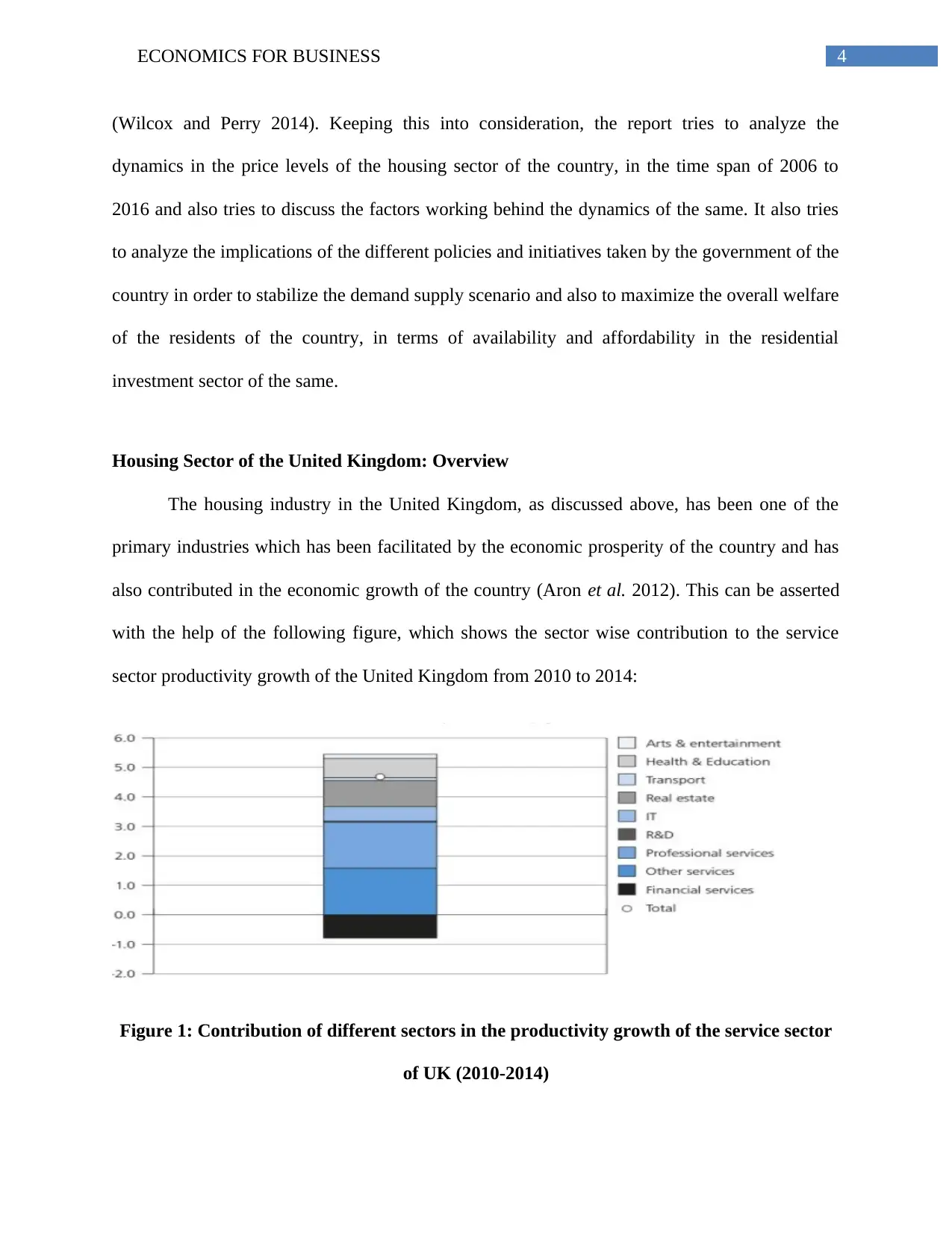
4ECONOMICS FOR BUSINESS
(Wilcox and Perry 2014). Keeping this into consideration, the report tries to analyze the
dynamics in the price levels of the housing sector of the country, in the time span of 2006 to
2016 and also tries to discuss the factors working behind the dynamics of the same. It also tries
to analyze the implications of the different policies and initiatives taken by the government of the
country in order to stabilize the demand supply scenario and also to maximize the overall welfare
of the residents of the country, in terms of availability and affordability in the residential
investment sector of the same.
Housing Sector of the United Kingdom: Overview
The housing industry in the United Kingdom, as discussed above, has been one of the
primary industries which has been facilitated by the economic prosperity of the country and has
also contributed in the economic growth of the country (Aron et al. 2012). This can be asserted
with the help of the following figure, which shows the sector wise contribution to the service
sector productivity growth of the United Kingdom from 2010 to 2014:
Figure 1: Contribution of different sectors in the productivity growth of the service sector
of UK (2010-2014)
(Wilcox and Perry 2014). Keeping this into consideration, the report tries to analyze the
dynamics in the price levels of the housing sector of the country, in the time span of 2006 to
2016 and also tries to discuss the factors working behind the dynamics of the same. It also tries
to analyze the implications of the different policies and initiatives taken by the government of the
country in order to stabilize the demand supply scenario and also to maximize the overall welfare
of the residents of the country, in terms of availability and affordability in the residential
investment sector of the same.
Housing Sector of the United Kingdom: Overview
The housing industry in the United Kingdom, as discussed above, has been one of the
primary industries which has been facilitated by the economic prosperity of the country and has
also contributed in the economic growth of the country (Aron et al. 2012). This can be asserted
with the help of the following figure, which shows the sector wise contribution to the service
sector productivity growth of the United Kingdom from 2010 to 2014:
Figure 1: Contribution of different sectors in the productivity growth of the service sector
of UK (2010-2014)
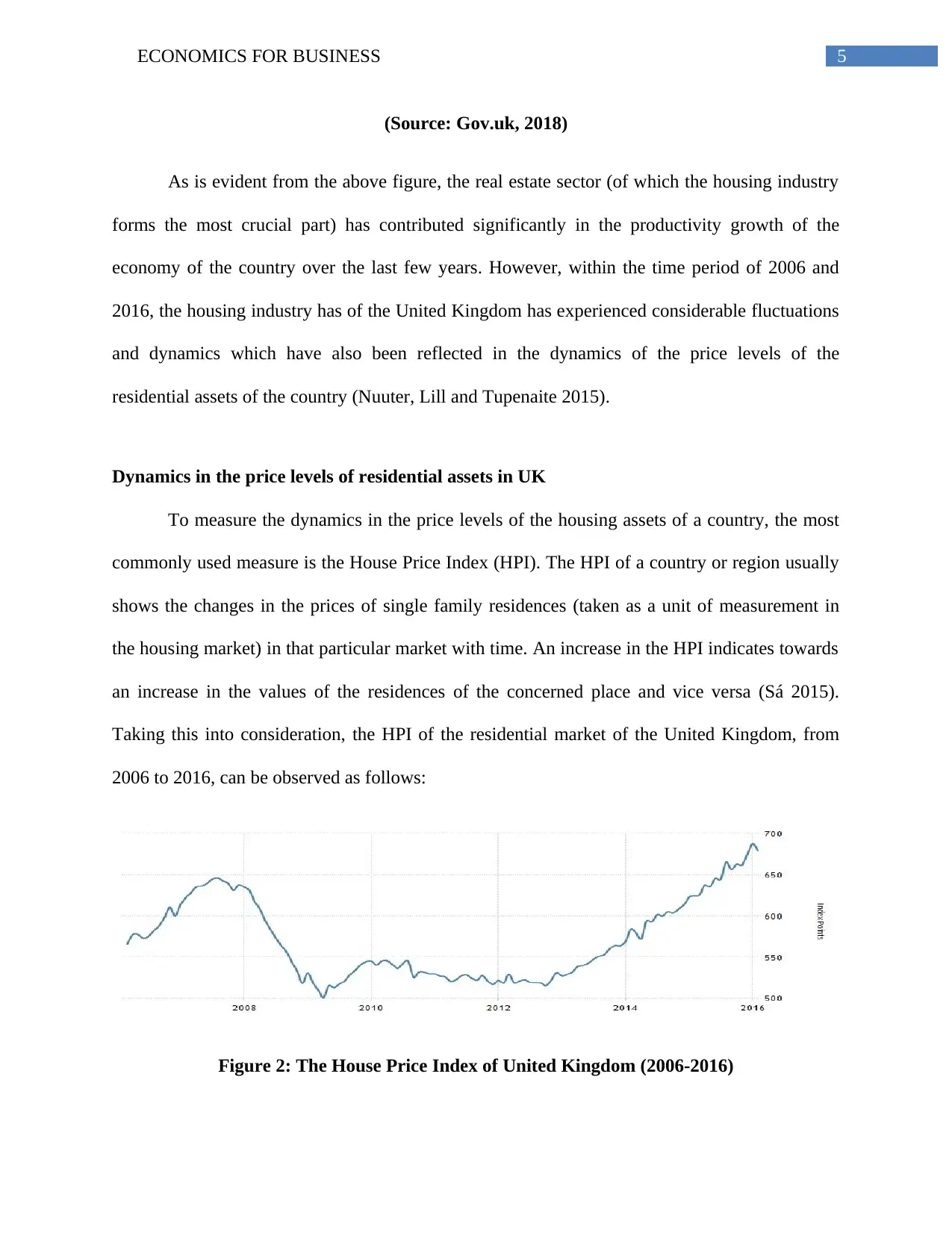
5ECONOMICS FOR BUSINESS
(Source: Gov.uk, 2018)
As is evident from the above figure, the real estate sector (of which the housing industry
forms the most crucial part) has contributed significantly in the productivity growth of the
economy of the country over the last few years. However, within the time period of 2006 and
2016, the housing industry has of the United Kingdom has experienced considerable fluctuations
and dynamics which have also been reflected in the dynamics of the price levels of the
residential assets of the country (Nuuter, Lill and Tupenaite 2015).
Dynamics in the price levels of residential assets in UK
To measure the dynamics in the price levels of the housing assets of a country, the most
commonly used measure is the House Price Index (HPI). The HPI of a country or region usually
shows the changes in the prices of single family residences (taken as a unit of measurement in
the housing market) in that particular market with time. An increase in the HPI indicates towards
an increase in the values of the residences of the concerned place and vice versa (Sá 2015).
Taking this into consideration, the HPI of the residential market of the United Kingdom, from
2006 to 2016, can be observed as follows:
Figure 2: The House Price Index of United Kingdom (2006-2016)
(Source: Gov.uk, 2018)
As is evident from the above figure, the real estate sector (of which the housing industry
forms the most crucial part) has contributed significantly in the productivity growth of the
economy of the country over the last few years. However, within the time period of 2006 and
2016, the housing industry has of the United Kingdom has experienced considerable fluctuations
and dynamics which have also been reflected in the dynamics of the price levels of the
residential assets of the country (Nuuter, Lill and Tupenaite 2015).
Dynamics in the price levels of residential assets in UK
To measure the dynamics in the price levels of the housing assets of a country, the most
commonly used measure is the House Price Index (HPI). The HPI of a country or region usually
shows the changes in the prices of single family residences (taken as a unit of measurement in
the housing market) in that particular market with time. An increase in the HPI indicates towards
an increase in the values of the residences of the concerned place and vice versa (Sá 2015).
Taking this into consideration, the HPI of the residential market of the United Kingdom, from
2006 to 2016, can be observed as follows:
Figure 2: The House Price Index of United Kingdom (2006-2016)
⊘ This is a preview!⊘
Do you want full access?
Subscribe today to unlock all pages.

Trusted by 1+ million students worldwide
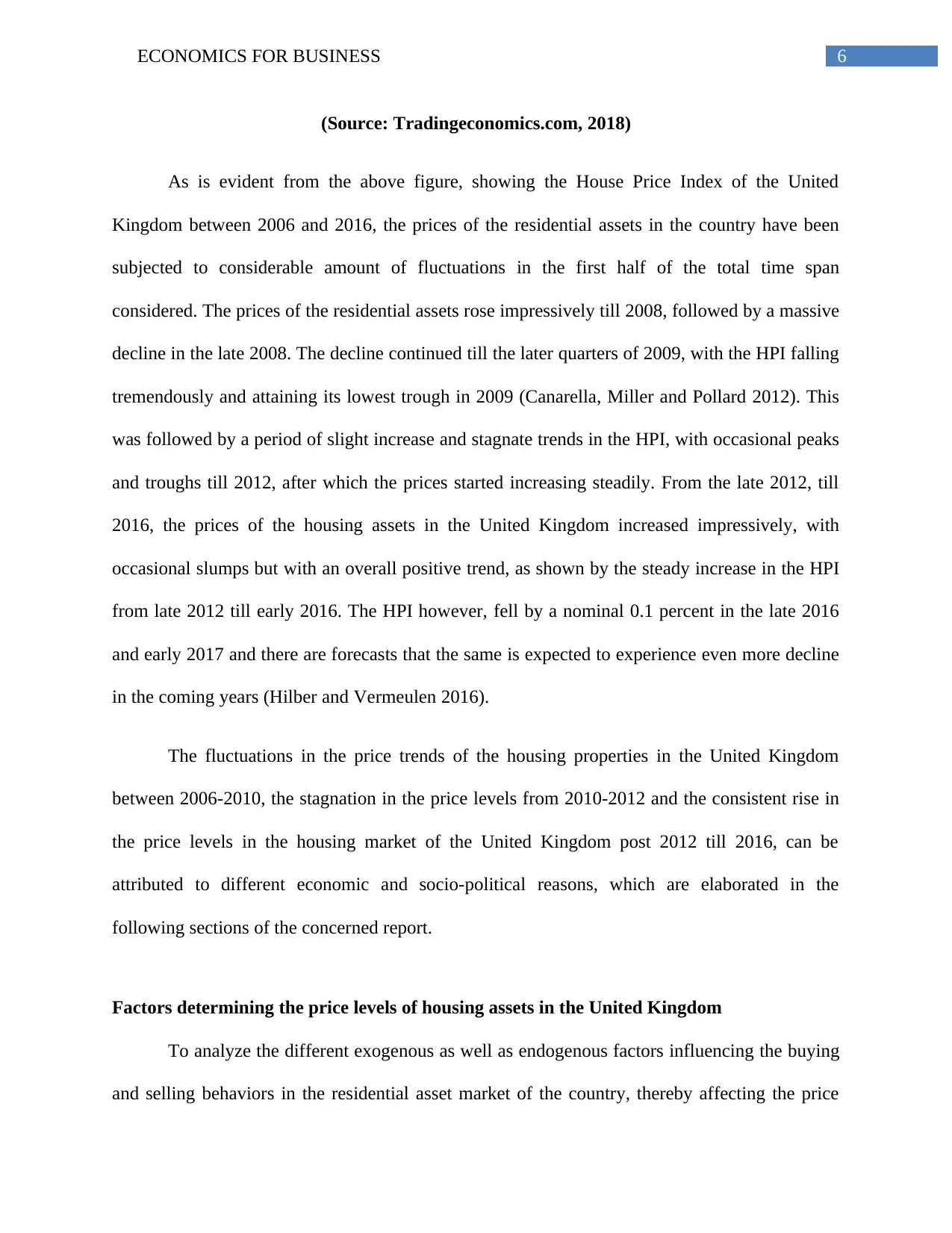
6ECONOMICS FOR BUSINESS
(Source: Tradingeconomics.com, 2018)
As is evident from the above figure, showing the House Price Index of the United
Kingdom between 2006 and 2016, the prices of the residential assets in the country have been
subjected to considerable amount of fluctuations in the first half of the total time span
considered. The prices of the residential assets rose impressively till 2008, followed by a massive
decline in the late 2008. The decline continued till the later quarters of 2009, with the HPI falling
tremendously and attaining its lowest trough in 2009 (Canarella, Miller and Pollard 2012). This
was followed by a period of slight increase and stagnate trends in the HPI, with occasional peaks
and troughs till 2012, after which the prices started increasing steadily. From the late 2012, till
2016, the prices of the housing assets in the United Kingdom increased impressively, with
occasional slumps but with an overall positive trend, as shown by the steady increase in the HPI
from late 2012 till early 2016. The HPI however, fell by a nominal 0.1 percent in the late 2016
and early 2017 and there are forecasts that the same is expected to experience even more decline
in the coming years (Hilber and Vermeulen 2016).
The fluctuations in the price trends of the housing properties in the United Kingdom
between 2006-2010, the stagnation in the price levels from 2010-2012 and the consistent rise in
the price levels in the housing market of the United Kingdom post 2012 till 2016, can be
attributed to different economic and socio-political reasons, which are elaborated in the
following sections of the concerned report.
Factors determining the price levels of housing assets in the United Kingdom
To analyze the different exogenous as well as endogenous factors influencing the buying
and selling behaviors in the residential asset market of the country, thereby affecting the price
(Source: Tradingeconomics.com, 2018)
As is evident from the above figure, showing the House Price Index of the United
Kingdom between 2006 and 2016, the prices of the residential assets in the country have been
subjected to considerable amount of fluctuations in the first half of the total time span
considered. The prices of the residential assets rose impressively till 2008, followed by a massive
decline in the late 2008. The decline continued till the later quarters of 2009, with the HPI falling
tremendously and attaining its lowest trough in 2009 (Canarella, Miller and Pollard 2012). This
was followed by a period of slight increase and stagnate trends in the HPI, with occasional peaks
and troughs till 2012, after which the prices started increasing steadily. From the late 2012, till
2016, the prices of the housing assets in the United Kingdom increased impressively, with
occasional slumps but with an overall positive trend, as shown by the steady increase in the HPI
from late 2012 till early 2016. The HPI however, fell by a nominal 0.1 percent in the late 2016
and early 2017 and there are forecasts that the same is expected to experience even more decline
in the coming years (Hilber and Vermeulen 2016).
The fluctuations in the price trends of the housing properties in the United Kingdom
between 2006-2010, the stagnation in the price levels from 2010-2012 and the consistent rise in
the price levels in the housing market of the United Kingdom post 2012 till 2016, can be
attributed to different economic and socio-political reasons, which are elaborated in the
following sections of the concerned report.
Factors determining the price levels of housing assets in the United Kingdom
To analyze the different exogenous as well as endogenous factors influencing the buying
and selling behaviors in the residential asset market of the country, thereby affecting the price
Paraphrase This Document
Need a fresh take? Get an instant paraphrase of this document with our AI Paraphraser
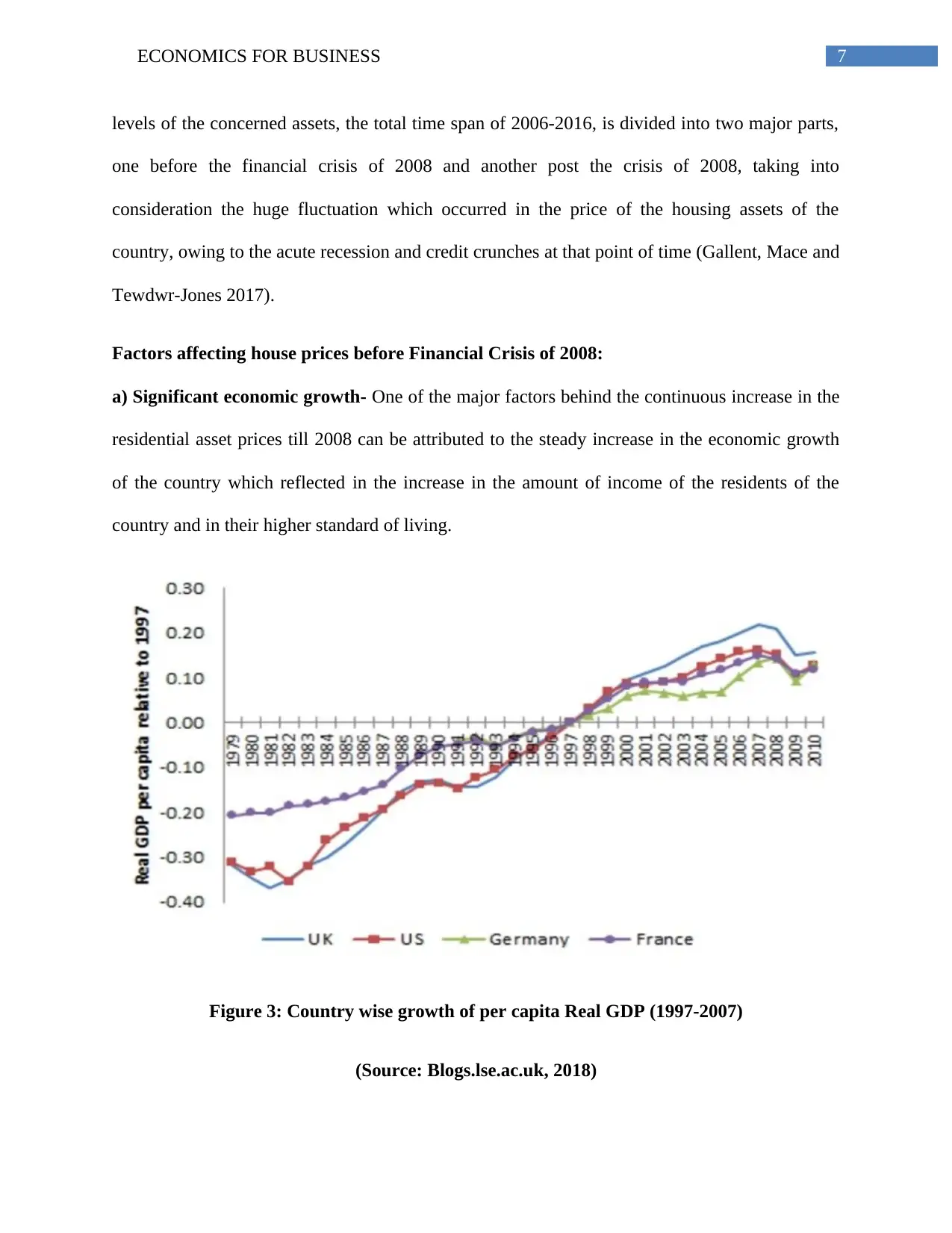
7ECONOMICS FOR BUSINESS
levels of the concerned assets, the total time span of 2006-2016, is divided into two major parts,
one before the financial crisis of 2008 and another post the crisis of 2008, taking into
consideration the huge fluctuation which occurred in the price of the housing assets of the
country, owing to the acute recession and credit crunches at that point of time (Gallent, Mace and
Tewdwr-Jones 2017).
Factors affecting house prices before Financial Crisis of 2008:
a) Significant economic growth- One of the major factors behind the continuous increase in the
residential asset prices till 2008 can be attributed to the steady increase in the economic growth
of the country which reflected in the increase in the amount of income of the residents of the
country and in their higher standard of living.
Figure 3: Country wise growth of per capita Real GDP (1997-2007)
(Source: Blogs.lse.ac.uk, 2018)
levels of the concerned assets, the total time span of 2006-2016, is divided into two major parts,
one before the financial crisis of 2008 and another post the crisis of 2008, taking into
consideration the huge fluctuation which occurred in the price of the housing assets of the
country, owing to the acute recession and credit crunches at that point of time (Gallent, Mace and
Tewdwr-Jones 2017).
Factors affecting house prices before Financial Crisis of 2008:
a) Significant economic growth- One of the major factors behind the continuous increase in the
residential asset prices till 2008 can be attributed to the steady increase in the economic growth
of the country which reflected in the increase in the amount of income of the residents of the
country and in their higher standard of living.
Figure 3: Country wise growth of per capita Real GDP (1997-2007)
(Source: Blogs.lse.ac.uk, 2018)
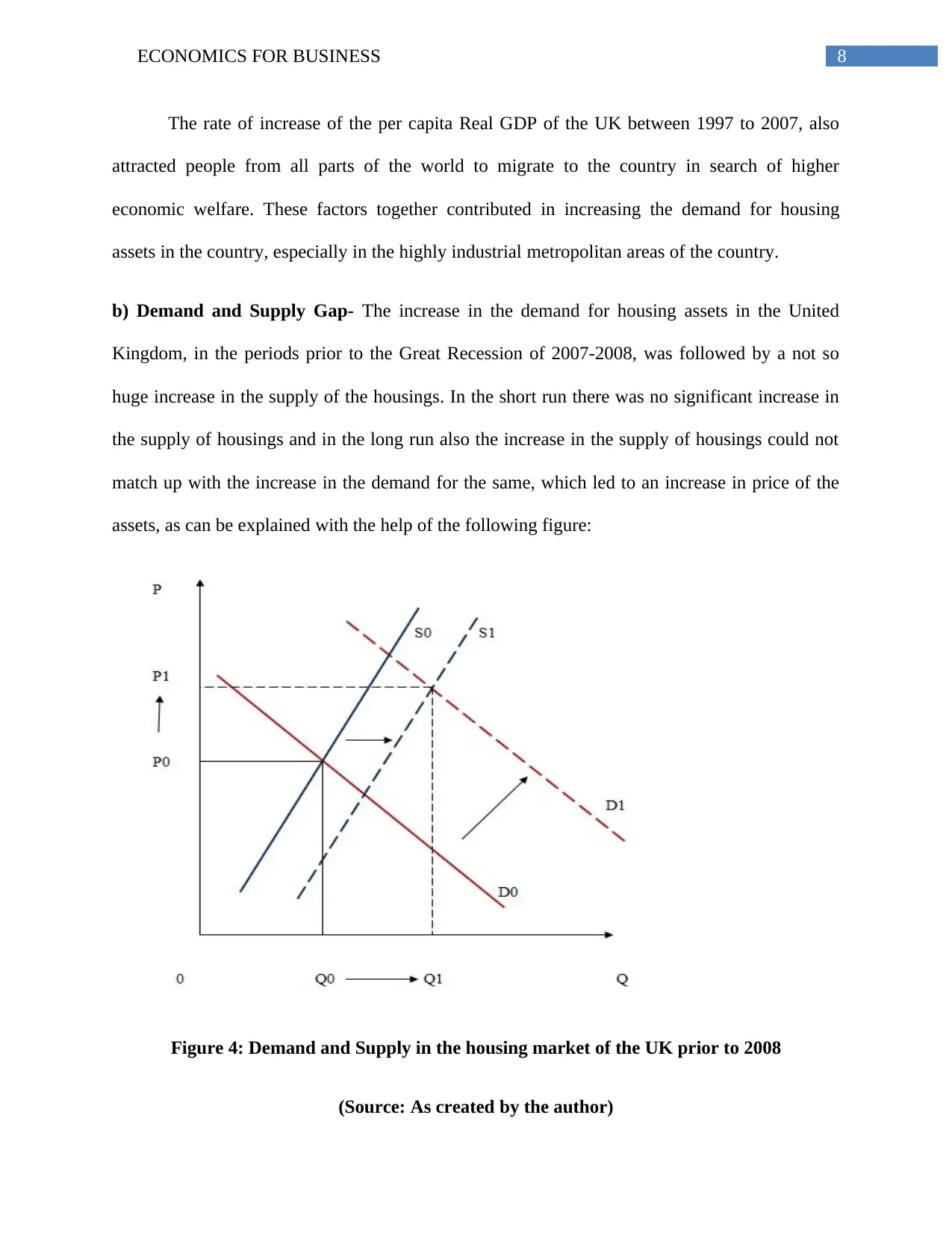
8ECONOMICS FOR BUSINESS
The rate of increase of the per capita Real GDP of the UK between 1997 to 2007, also
attracted people from all parts of the world to migrate to the country in search of higher
economic welfare. These factors together contributed in increasing the demand for housing
assets in the country, especially in the highly industrial metropolitan areas of the country.
b) Demand and Supply Gap- The increase in the demand for housing assets in the United
Kingdom, in the periods prior to the Great Recession of 2007-2008, was followed by a not so
huge increase in the supply of the housings. In the short run there was no significant increase in
the supply of housings and in the long run also the increase in the supply of housings could not
match up with the increase in the demand for the same, which led to an increase in price of the
assets, as can be explained with the help of the following figure:
Figure 4: Demand and Supply in the housing market of the UK prior to 2008
(Source: As created by the author)
The rate of increase of the per capita Real GDP of the UK between 1997 to 2007, also
attracted people from all parts of the world to migrate to the country in search of higher
economic welfare. These factors together contributed in increasing the demand for housing
assets in the country, especially in the highly industrial metropolitan areas of the country.
b) Demand and Supply Gap- The increase in the demand for housing assets in the United
Kingdom, in the periods prior to the Great Recession of 2007-2008, was followed by a not so
huge increase in the supply of the housings. In the short run there was no significant increase in
the supply of housings and in the long run also the increase in the supply of housings could not
match up with the increase in the demand for the same, which led to an increase in price of the
assets, as can be explained with the help of the following figure:
Figure 4: Demand and Supply in the housing market of the UK prior to 2008
(Source: As created by the author)
⊘ This is a preview!⊘
Do you want full access?
Subscribe today to unlock all pages.

Trusted by 1+ million students worldwide
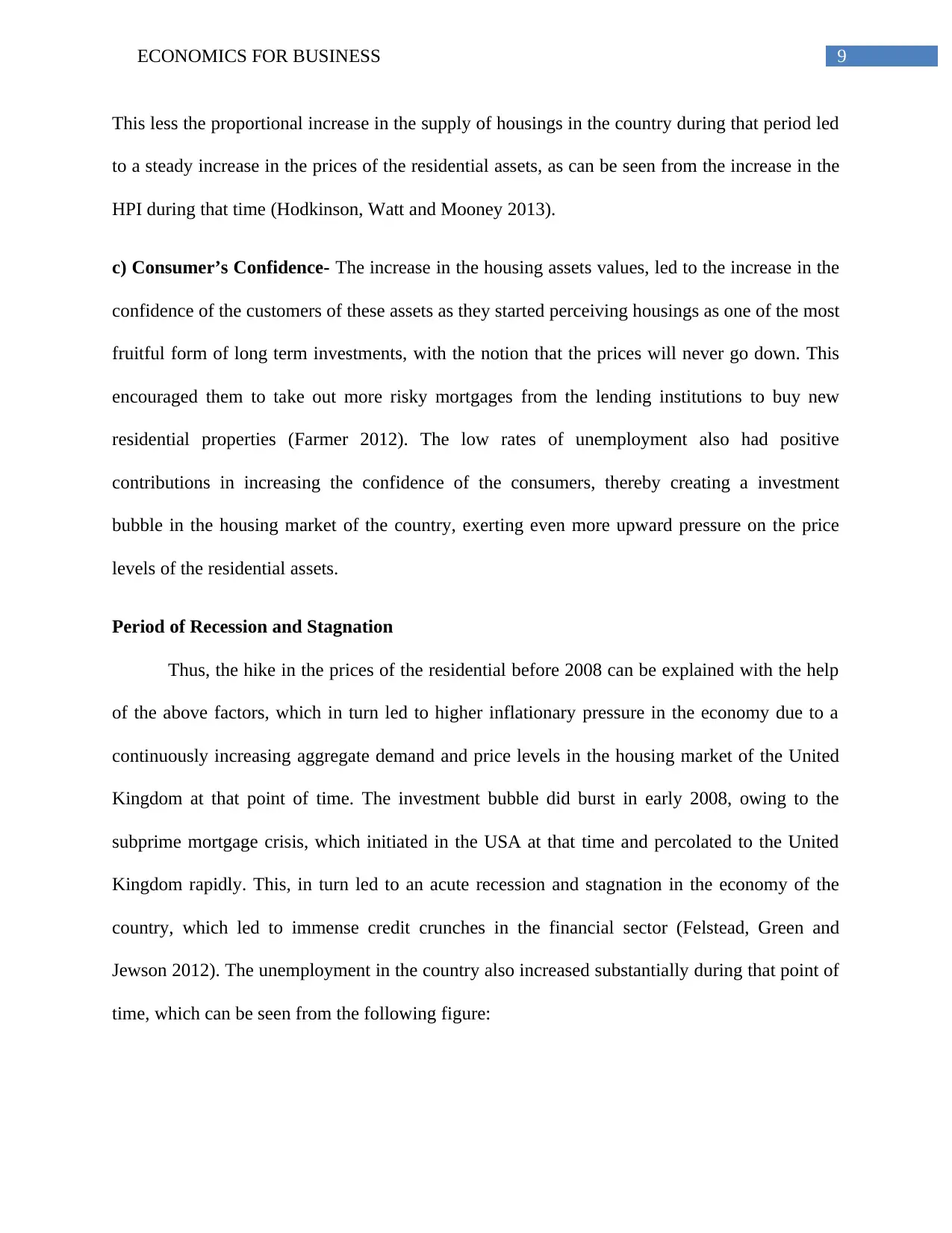
9ECONOMICS FOR BUSINESS
This less the proportional increase in the supply of housings in the country during that period led
to a steady increase in the prices of the residential assets, as can be seen from the increase in the
HPI during that time (Hodkinson, Watt and Mooney 2013).
c) Consumer’s Confidence- The increase in the housing assets values, led to the increase in the
confidence of the customers of these assets as they started perceiving housings as one of the most
fruitful form of long term investments, with the notion that the prices will never go down. This
encouraged them to take out more risky mortgages from the lending institutions to buy new
residential properties (Farmer 2012). The low rates of unemployment also had positive
contributions in increasing the confidence of the consumers, thereby creating a investment
bubble in the housing market of the country, exerting even more upward pressure on the price
levels of the residential assets.
Period of Recession and Stagnation
Thus, the hike in the prices of the residential before 2008 can be explained with the help
of the above factors, which in turn led to higher inflationary pressure in the economy due to a
continuously increasing aggregate demand and price levels in the housing market of the United
Kingdom at that point of time. The investment bubble did burst in early 2008, owing to the
subprime mortgage crisis, which initiated in the USA at that time and percolated to the United
Kingdom rapidly. This, in turn led to an acute recession and stagnation in the economy of the
country, which led to immense credit crunches in the financial sector (Felstead, Green and
Jewson 2012). The unemployment in the country also increased substantially during that point of
time, which can be seen from the following figure:
This less the proportional increase in the supply of housings in the country during that period led
to a steady increase in the prices of the residential assets, as can be seen from the increase in the
HPI during that time (Hodkinson, Watt and Mooney 2013).
c) Consumer’s Confidence- The increase in the housing assets values, led to the increase in the
confidence of the customers of these assets as they started perceiving housings as one of the most
fruitful form of long term investments, with the notion that the prices will never go down. This
encouraged them to take out more risky mortgages from the lending institutions to buy new
residential properties (Farmer 2012). The low rates of unemployment also had positive
contributions in increasing the confidence of the consumers, thereby creating a investment
bubble in the housing market of the country, exerting even more upward pressure on the price
levels of the residential assets.
Period of Recession and Stagnation
Thus, the hike in the prices of the residential before 2008 can be explained with the help
of the above factors, which in turn led to higher inflationary pressure in the economy due to a
continuously increasing aggregate demand and price levels in the housing market of the United
Kingdom at that point of time. The investment bubble did burst in early 2008, owing to the
subprime mortgage crisis, which initiated in the USA at that time and percolated to the United
Kingdom rapidly. This, in turn led to an acute recession and stagnation in the economy of the
country, which led to immense credit crunches in the financial sector (Felstead, Green and
Jewson 2012). The unemployment in the country also increased substantially during that point of
time, which can be seen from the following figure:
Paraphrase This Document
Need a fresh take? Get an instant paraphrase of this document with our AI Paraphraser
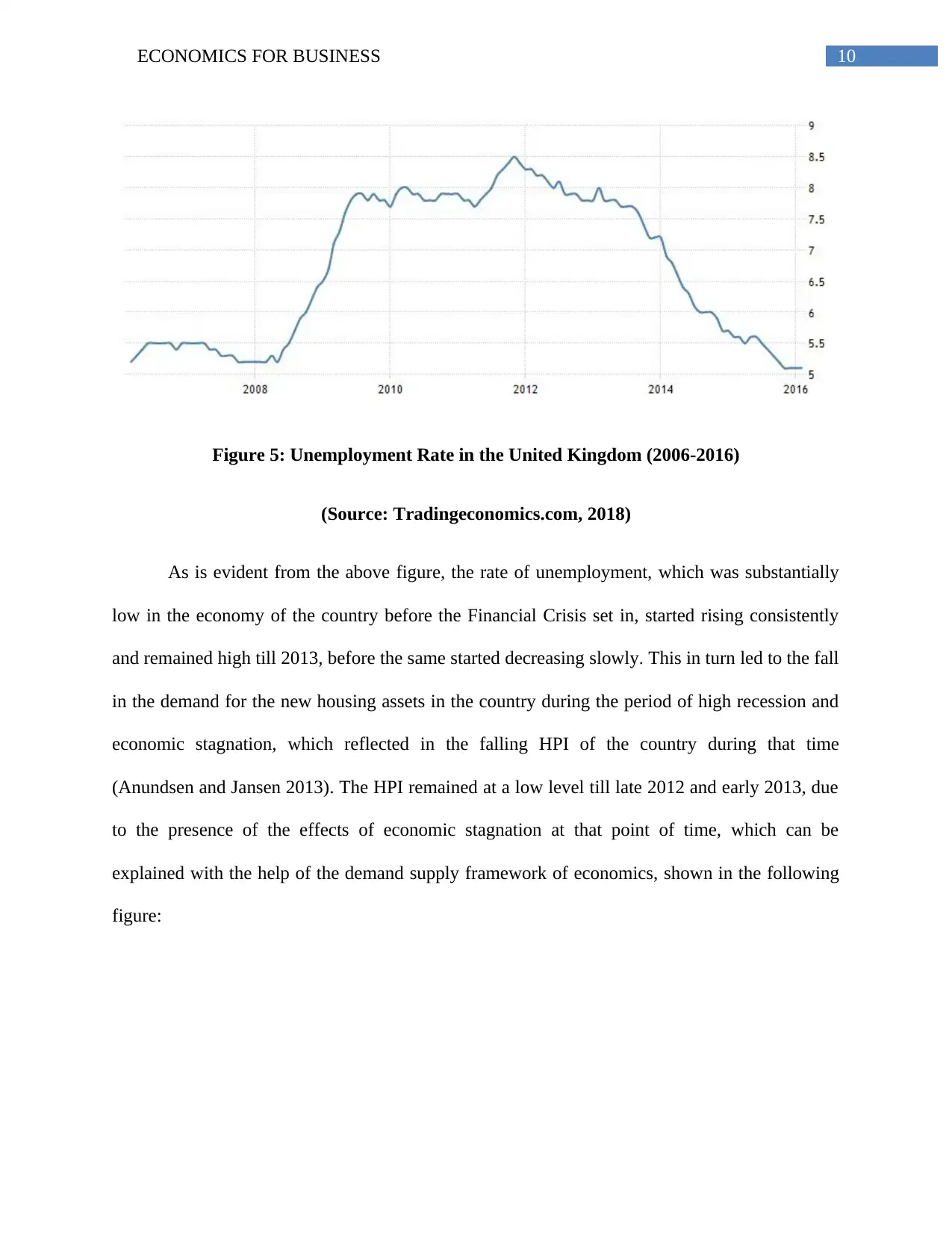
10ECONOMICS FOR BUSINESS
Figure 5: Unemployment Rate in the United Kingdom (2006-2016)
(Source: Tradingeconomics.com, 2018)
As is evident from the above figure, the rate of unemployment, which was substantially
low in the economy of the country before the Financial Crisis set in, started rising consistently
and remained high till 2013, before the same started decreasing slowly. This in turn led to the fall
in the demand for the new housing assets in the country during the period of high recession and
economic stagnation, which reflected in the falling HPI of the country during that time
(Anundsen and Jansen 2013). The HPI remained at a low level till late 2012 and early 2013, due
to the presence of the effects of economic stagnation at that point of time, which can be
explained with the help of the demand supply framework of economics, shown in the following
figure:
Figure 5: Unemployment Rate in the United Kingdom (2006-2016)
(Source: Tradingeconomics.com, 2018)
As is evident from the above figure, the rate of unemployment, which was substantially
low in the economy of the country before the Financial Crisis set in, started rising consistently
and remained high till 2013, before the same started decreasing slowly. This in turn led to the fall
in the demand for the new housing assets in the country during the period of high recession and
economic stagnation, which reflected in the falling HPI of the country during that time
(Anundsen and Jansen 2013). The HPI remained at a low level till late 2012 and early 2013, due
to the presence of the effects of economic stagnation at that point of time, which can be
explained with the help of the demand supply framework of economics, shown in the following
figure:
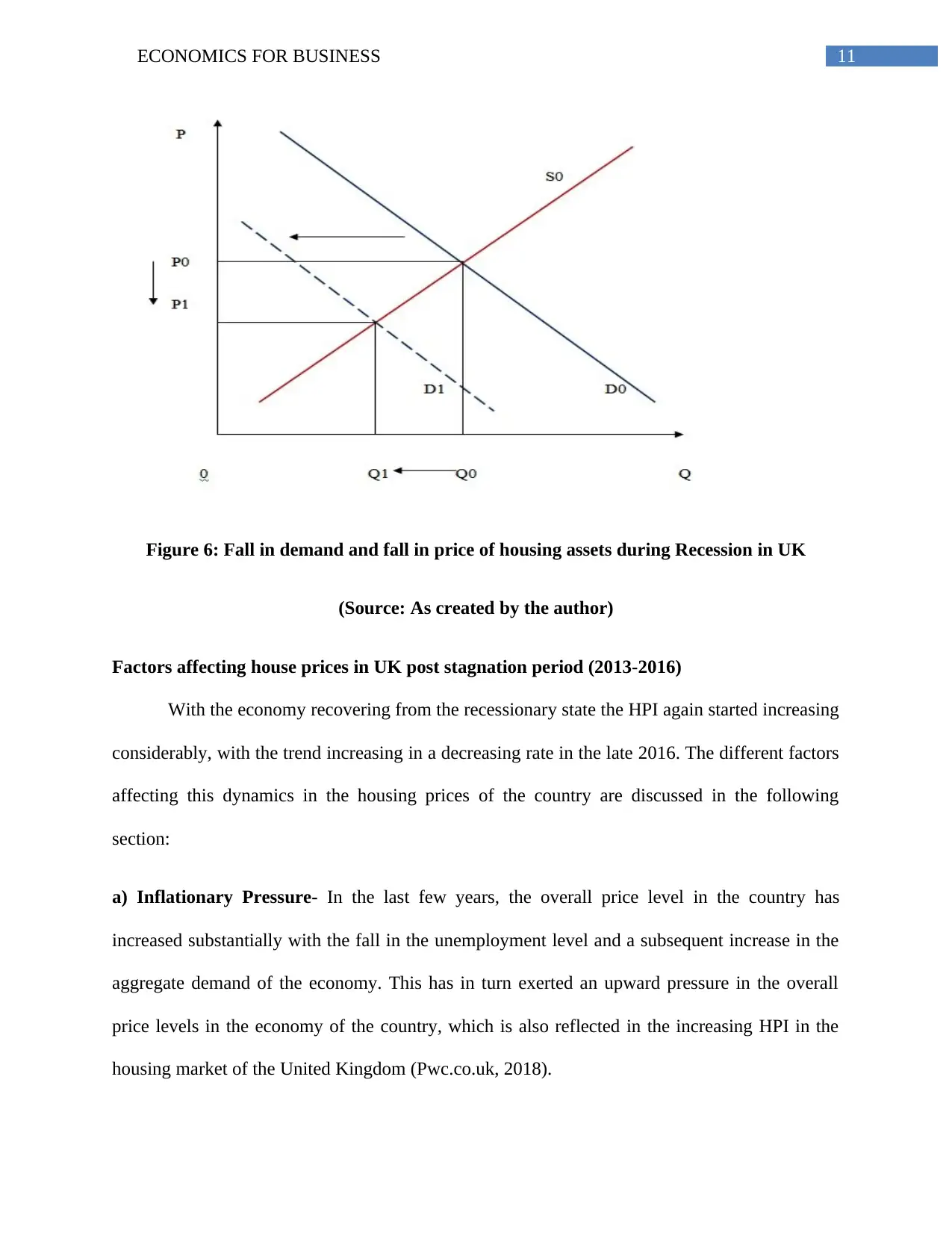
11ECONOMICS FOR BUSINESS
Figure 6: Fall in demand and fall in price of housing assets during Recession in UK
(Source: As created by the author)
Factors affecting house prices in UK post stagnation period (2013-2016)
With the economy recovering from the recessionary state the HPI again started increasing
considerably, with the trend increasing in a decreasing rate in the late 2016. The different factors
affecting this dynamics in the housing prices of the country are discussed in the following
section:
a) Inflationary Pressure- In the last few years, the overall price level in the country has
increased substantially with the fall in the unemployment level and a subsequent increase in the
aggregate demand of the economy. This has in turn exerted an upward pressure in the overall
price levels in the economy of the country, which is also reflected in the increasing HPI in the
housing market of the United Kingdom (Pwc.co.uk, 2018).
Figure 6: Fall in demand and fall in price of housing assets during Recession in UK
(Source: As created by the author)
Factors affecting house prices in UK post stagnation period (2013-2016)
With the economy recovering from the recessionary state the HPI again started increasing
considerably, with the trend increasing in a decreasing rate in the late 2016. The different factors
affecting this dynamics in the housing prices of the country are discussed in the following
section:
a) Inflationary Pressure- In the last few years, the overall price level in the country has
increased substantially with the fall in the unemployment level and a subsequent increase in the
aggregate demand of the economy. This has in turn exerted an upward pressure in the overall
price levels in the economy of the country, which is also reflected in the increasing HPI in the
housing market of the United Kingdom (Pwc.co.uk, 2018).
⊘ This is a preview!⊘
Do you want full access?
Subscribe today to unlock all pages.

Trusted by 1+ million students worldwide
1 out of 21
Related Documents
Your All-in-One AI-Powered Toolkit for Academic Success.
+13062052269
info@desklib.com
Available 24*7 on WhatsApp / Email
![[object Object]](/_next/static/media/star-bottom.7253800d.svg)
Unlock your academic potential
Copyright © 2020–2025 A2Z Services. All Rights Reserved. Developed and managed by ZUCOL.





